ConsumerReports.org Buying Guide: Flooring
 Tuesday, August 21, 2012 at 12:00PM
Tuesday, August 21, 2012 at 12:00PM 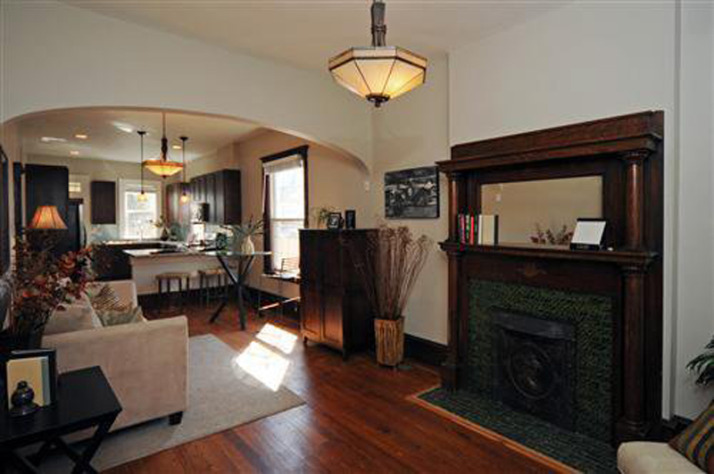 Photo: American Cabinet & Flooring Designer Clay Bernard
Photo: American Cabinet & Flooring Designer Clay Bernard
Getting Started
Begin by considering where the flooring will go and how much traffic, sunlight, and other wear and tear it will get. Vinyl proved tops in our moisture tests and most linoleum. Plastic laminates, and solid wood fared nearly as well. But many engineered woods, as well as some solid woods, and a linoleum product we tested flubbed that test - a serious drawback in a busy kitchen. And while the best vinyls and plastic-laminates fended off wear better than solid wood, they can't be refinished when worn.
How to Shop
Before settling on a product, spend a few dollars on two or three samples. That can be a lot less expensive than winding up with flooring that looks great in a catalog or on a website and then awful in your home. Manufacturers generally match most wood or engineered-wood flooring for color or grain. But variations can occur from one batch to the next, so buy the flooring you'll need all at once. All the plastic-laminate floorboards in a package often have a similar pattern, so you may want to pull from multiple packages to avoid repetition.
To determine how much flooring you'll need, measure the room's square footage by multiplying its length times its width. (Divide an irregularly shaped room into smaller rectangles, calculate the square footage of each rectangle, and then add them together.) Then buy 7 to 10 percent extra to allow for mistakes, bad samples, and waste. You might also want to invest in an extra box of flooring for future repairs or additions.
Where to Save
One way to save is on overstocks. Also, take advantage of mistakes. You can often save on opened or damaged boxes or on flooring with minor flaws that no one will notice.
Hiring a pro to do the installation? You can trim hundreds of dollars off the job by doing the time-consuming prep work like prying up the old flooring, leveling or filling the subfloor, and removing any baseboard that's in the way.
Green Floors That Didn't Cut It
Bamboo is considered renewable because it's a fast-growing grass. The best bamboo floorings we tested area stranded products such as the EcoTimber solid and Teragren engineered flooring, which are made of fibers that are shredded and compressed for strength. Cork floors are made of tree bark in a process that doesn't kill trees.
Know How Rough You'll Be
The best products in every category were also the best overall in our simulated foot-traffic tests. For less busy kitchens, you may want to consider the top engineered wood or bamboo, with its blend of natural veneer and easy installation.
Pick a Factory Finish
Prefinished wood and bamboo floors cost about 40 percent more than unfinished products. But you're likely to save overall because a factory finish tends to last longer-and paying a pro to apply the finish adds costs, mess, and hassle. Factory finishes are also warranted by the manufacturer.
Check for Certification
Vinyl floors with the industry's FloorScore certification emit relatively low levels of volatile organic compounds, substances linked to health problems and pollution. All vinyl we recommend has that certification. For wood flooring, certification by the Forest Stewardship Council and the Sustainable Forestry Initiative offers some assurance that it comes from responsibly managed forests, a plus for the planet. The product and manufacturer must be certified; check the packaging.
When You Get it Home
Before installing wood or laminate flooring, unpack it and let it sit for one to three days in the space where it will be installed so that its temperature and moisture match the levels in the room.
Keeping New Floors Looking Good
If you need to heat the room soon after installation, raise the temperature gradually over the course of a week - especially if you have radiant heat - to allow the flooring to adjust. Sweep or vacuum floors with a soft broom or brush, and clean with a damp but not overly wet mop. Check the manufacturer's guidelines for recommended cleaning products. And put felt pads under furniture to prevent scratching.
Types of Flooring
Though you'll find a growing array of styles, most flooring falls into one of these six types. The type of flooring you choose will depend on your taste, needs, and budget.
Solid Wood
 Photo: Mohawk Solid Wood in Oak ButterscotchAdvantages include its natural warmth and the ability to be sanded and refinished several times, along with impressive wear resistance for some. But except for the best solid bamboo, all the solid-wood products we tested dented easily, and some wore quickly and became discolored from sunlight. Pre-finished floors should hold up better than those finished on site, and their warranty comes from the factory, not the installer. But you may not like the beveled edges on many pre-finished products. While unfinished flooring costs about 40 percent less, higher installation costs can offset those savings, since the floor must be sanded and finished over several days to seal it from moisture. Wood flooring shouldn't go in basements and other damp spaces.
Photo: Mohawk Solid Wood in Oak ButterscotchAdvantages include its natural warmth and the ability to be sanded and refinished several times, along with impressive wear resistance for some. But except for the best solid bamboo, all the solid-wood products we tested dented easily, and some wore quickly and became discolored from sunlight. Pre-finished floors should hold up better than those finished on site, and their warranty comes from the factory, not the installer. But you may not like the beveled edges on many pre-finished products. While unfinished flooring costs about 40 percent less, higher installation costs can offset those savings, since the floor must be sanded and finished over several days to seal it from moisture. Wood flooring shouldn't go in basements and other damp spaces.
Engineered Wood
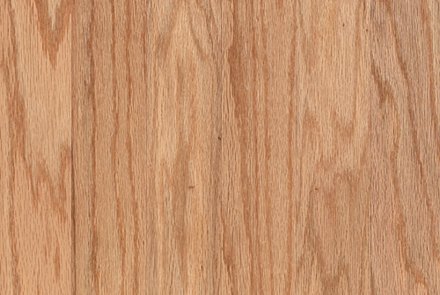 Photo: Mohawk Engineered Wood in Oak Natural
Photo: Mohawk Engineered Wood in Oak Natural
This flooring uses a thin veneer of real wood or bamboo over structural plywood. Most engineered wood doesn't wear as well as solid wood or plastic laminate. It also dents easily, and small spills can damage it. Most can be carefully refinished once, but the veneer on some may be too thin.
Plastic Laminate
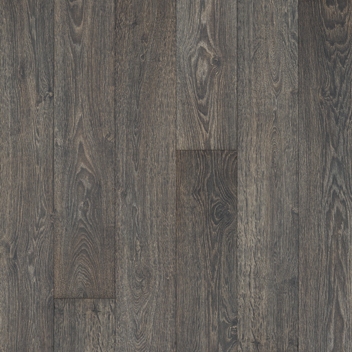 Photo: Mannington Laminate in Black Forest Oak
Photo: Mannington Laminate in Black Forest Oak
Generally made of dense fiberboard with a photo beneath a clear plastic protective layer, laminate can mimic nearly anything from oak to marble. Some brands use real cork beneath the clear layer. But the repetitive pattern on some products compromises realism. The best laminates resist scratching, denting, and discoloration from sunlight better than most wood products, but as with engineered wood, a big spill can cause damage. You may be able to touch up minor flaws, but you'll have to replace the flooring when its outer layer wears through.
Vinyl
 Photo: Shaw Resilient Vinyl Tile in Grey Skies
Photo: Shaw Resilient Vinyl Tile in Grey Skies
This option can be especially good at fending off wear, dents, scratches, discoloration from sunlight, and stains. Easy installation is another plus, especially for tiles or planks, as are more color and design choices than before. Premium vinyl does a better job of imitating stone, tile, and even oak, but even the best products still look like vinyl. And the best can cost at least as much as the best solid wood and laminate floors.
Linoleum
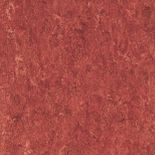 Photo: Armstrong Linoleum in Firebird Red
Photo: Armstrong Linoleum in Firebird Red
Made of linseed oil and wood products, linoleum is a natural, resilient material. Today's products offer far more styles and colors. Linoleum tends to fend off discoloration from sunlight, but resistance to wear, scratches, dents and moisture has varied widely in our tests from product to product. Linoleum can also be relatively expensive.
Ceramic Tile
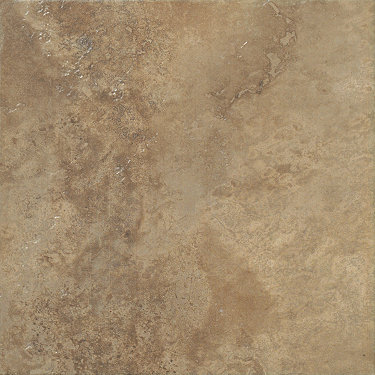 Photo: Shaw Ceramic Tile In Cappuccino
Photo: Shaw Ceramic Tile In Cappuccino
This classic material tends to resist wear, moisture, scratches, dents, and stains. But tiles can crack and grout can stain, and dropped cups and dishes break more easily on its hard surface. It's also relatively expensive and hard to install. While some can now be floated without the usual cement and grout, that makes replacing cracked tiles a challenge.
Flooring Features
Different flooring materials require different installation techniques. Homeowners install about half of all flooring. Floated floors that go down without glue or fasteners are easiest. In the case of vinyl, planks or tiles; they are easier to install than sheets.
- Nail- or Staple-Down Installation: These are the methods of choice with solid wood and engineered wood over a wood subfloor. Standard, ¾-inch-thick solid-wood strip and plank flooring is traditionally nailed to the subfloor; thinner solid or engineered material is almost always stapled. The fasteners are usually driven diagonally through the tongue side of the material and into the subfloor (blind-nailed) so they are invisible once the floor is finished. Solid flooring can also be nailed straight through the surface (face-nailed) with decorative cut nails or fastened with screws, which are typically countersunk and concealed with wood plugs. Installers often sandwich a layer of 15-pound felt or rosin paper between the subfloor and floor to prevent moisture between the two and to deaden sound.
- Floating Installation: This works with engineered wood, plastic laminate, linoleum and some ceramic tile over a wood or concrete subfloor or existing flooring. Tongue-and-groove planks or tiles lock together mechanically. Some products must also be glued together at the joints. The material generally goes over a thin foam or cork pad, which fills minor flaws in the subfloor and absorbs sound. Installations over concrete require a thin plastic vapor barrier.
- Glue-Down Installation: Engineered wood, vinyl, linoleum, and tiles are typically glued. You trowel adhesive onto a clean, flat, wood or concrete subfloor or existing flooring and lay down the sheets, planks, or tiles. No vapor barrier is required. Some glue-down flooring is simply peel-and-stick, the easiest to install. You'll also find vinyl flooring in sheets and easier-to-install tiles.
Flooring Brands
The national flooring brands listed below are sold by home centers and specialty flooring retailers. Use these profiles to compare flooring by brand.
 Armstrong manufactures flooring under the well-recognized brand names Armstrong and Bruce, and the speciality brand Robbins. Armstrong is also the brand leader in vinyl sheet and vinyl-tile flooring, dominating the category with more than 40 percent of sales. The Armstrong brand also includes wood and laminate, a line of linoleum flooring, and has recently added ceramic tile.
Armstrong manufactures flooring under the well-recognized brand names Armstrong and Bruce, and the speciality brand Robbins. Armstrong is also the brand leader in vinyl sheet and vinyl-tile flooring, dominating the category with more than 40 percent of sales. The Armstrong brand also includes wood and laminate, a line of linoleum flooring, and has recently added ceramic tile.
 Mannington is a one-stop floor manufacture with products in every flooring category. They are among the top three leading vinyl flooring brands and have a foothold in wood, laminate, and porcelain tile. A recent innovation is the Adura Luxury line of premium vinyl tile and planks that mimic the look of hardwood and ceramic tile. Mannington is available only through speciality flooring stores.
Mannington is a one-stop floor manufacture with products in every flooring category. They are among the top three leading vinyl flooring brands and have a foothold in wood, laminate, and porcelain tile. A recent innovation is the Adura Luxury line of premium vinyl tile and planks that mimic the look of hardwood and ceramic tile. Mannington is available only through speciality flooring stores.
This leading carpet manufacturer crossed over to hard-surface flooring through acquisitions and partnerships and now offers wood, laminate, and vinyl flooring.
 Mohawk sells stone flooring under the American Olean brand and laminate under the Quick-Step brand. Their Dal-Tile brand accounts for half of the ceramic tile category sales.
Mohawk sells stone flooring under the American Olean brand and laminate under the Quick-Step brand. Their Dal-Tile brand accounts for half of the ceramic tile category sales.
 In vinyl, Mohawk distributes the Congoleum brand through its vast dealer network. Mohawk flooring is sold through mass home centers and specialty floor stores and is one of the few flooring manufacturers that takes part directly at retail by licensing its trade names - Mohawk Floorz and Mohawk FloorScapes - to locally owned flooring specialty dealers.
In vinyl, Mohawk distributes the Congoleum brand through its vast dealer network. Mohawk flooring is sold through mass home centers and specialty floor stores and is one of the few flooring manufacturers that takes part directly at retail by licensing its trade names - Mohawk Floorz and Mohawk FloorScapes - to locally owned flooring specialty dealers.
This leading carpet manufacturer now offers wood, laminate, and ceramic-tile flooring; it recently expanded its presence in wood through the acquisition of Anderson Flooring. Shaw is available through home-center chains and specialty flooring stores and has its own retail programs - Shaw Design Center and Shaw Flooring Alliance that offer local dealers expanded product lines, display assistance, and training.
Tarkett
Originally a European manufacturer of linoleum, Tarkett is now among the largest flooring manufacturers worldwide. Tarkett offers wood, laminate, and vinyl flooring under its own brand, and luxury vinyl tile from Nafco. Tarket also makes FiberFloor, a water-resistant flooring that combines the qualities of carpet and vinyl. Tarkett is available through mass home centers and specialty flooring retailers.
 Photo: American Cabinet & Flooring Showroom
Photo: American Cabinet & Flooring Showroom
Copyright © 2006-2012 Consumers Union of U.S., Inc.



















